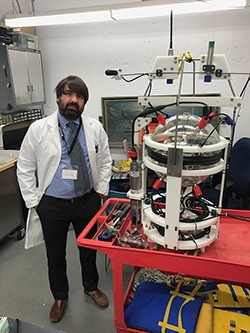Canadian researchers have found they can determine the levels of acidity in the ocean by listening to sounds found well below the water's surface with the help of an acoustic profiler developed at Dalhousie and deployed to some of the deepest parts of the global ocean.
 The research, published in the and co-authored by Dr. David Barclay, an associate professor in Department of Oceanography, was done by analyzing sounds gathered from 2009 to 2021 in the Philippine Sea, Mariana Trench and Tonga Trench.
The research, published in the and co-authored by Dr. David Barclay, an associate professor in Department of Oceanography, was done by analyzing sounds gathered from 2009 to 2021 in the Philippine Sea, Mariana Trench and Tonga Trench.
The data — vertical ambient sound profiles — were gathered by a free-falling autonomous instrument platform, known as Deep Sound, at depths ranging from 500 metres to 10 kilometres.
Sound loses a small amount of energy to dissolved salts in seawater. This loss of energy shapes the quality, or timbre, of noise made by breaking waves at the ocean's surface, as you descend into the deep ocean. The changes in the spread of frequencies of the noise can be related to the amount and type of salts in the seawater, which indicates the acidity of seawater.
The chemistry of the ocean is undergoing significant changes due to the uptake of carbon dioxide from the atmosphere. As the ocean continues to absorb more CO2, the pH decreases and the ocean becomes more acidic, resulting in adverse effects on marine life, particularly on tropical species.
Read the full paper:Ěý

